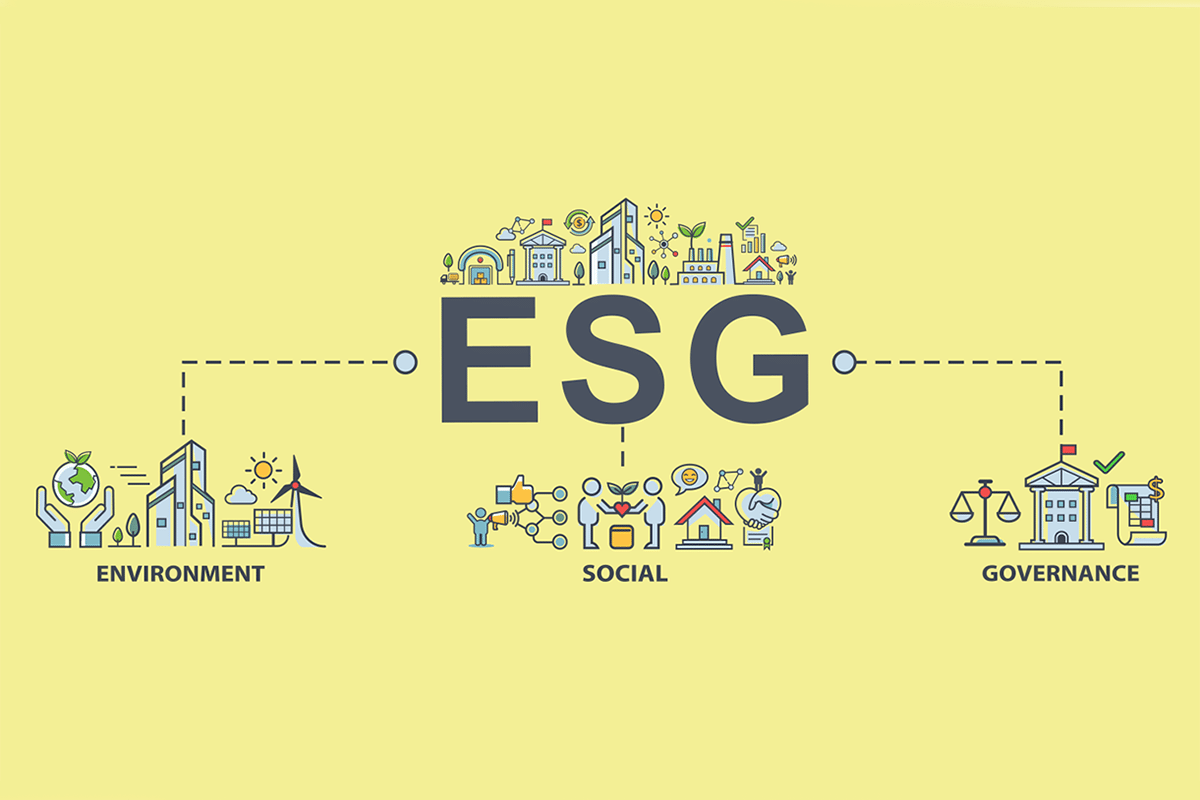ESG is Everywhere. Should It Matter to Nonprofits?
Nonprofits can learn from the for-profit sector’s efforts on ESG and begin to think about how these corporate strategies can apply to their work as well.

What is ESG?
Environmental, Social, and Governance (ESG) is a framework used primarily in the corporate sector to measure sustainability; however, this measurement of sustainability not only relates to the environment but also the ethics of the business.
- Environmental refers to factors that impact the environment, such as carbon emissions, waste reduction, and a more sustainable supply chain.
- Social focuses on the organization’s relationship with its stakeholders. It can include issues such as ensuring the diversity, equal opportunity, and non-discrimination of the workforce as well as delivering services equitably, safeguarding workforce health and safety, and increasing the use of diverse suppliers.
- Governance tracks how well the organization is led through progress in the areas of board diversity, risk management, data responsibility, and compliance and ethics.
Those of us in the nonprofit sector may be more familiar with the term Corporate Social Responsibility (CSR), another framework used by corporations to demonstrate that they are socially conscious. Historically, however, CSR has been more internally focused and self-regulated.
In contrast, ESG establishes metrics to allow investors to value a business beyond looking at financial indicators. ESG is for external stakeholders seeking to better measure and understand the sustainability and long-term viability of the business.
While businesses could utilize both ESG and CSR, the focus has shifted from CSR to ESG in recent years.
Why is the corporate sector focused on ESG?
For the most part, ESG disclosures have been voluntary in the United States; however, in early 2022 the Securities and Exchange Commission (SEC) announced a proposal that would require publicly traded companies to make certain climate-related disclosures.
But even without these regulations, more and more corporations have been focusing on ESG in response to demands from their shareholders, investors, employees, and other constituents. Entities such as the World Economic Forum and the International Business Council have convened corporations to establish a set of standardized metrics aligned with the United Nations’ 2030 Agenda for Sustainable Development. These activities all indicate that ESG is here to stay.
It bears mentioning that although ESG frameworks and investing are becoming more and more common, there has also been pushback. Criticism ranges from concerns that the emphasis on ESG is not making the meaningful difference on the environment that is needed, all the way to accusations of greenwashing where corporations make false claims about how environmentally sound their products and practices are, under the guise of ESG.
Should ESG matter to nonprofits?
Many nonprofits consider ESG in the context of how the funds in their endowments are invested. And this makes sense: a nonprofit focused on social good should be mindful of its investments and whether or not they support the organization’s values.
However, investments are only the tip of the iceberg. To illustrate this connection between ESG and the eventual impact it could have on the nonprofit sector, it’s helpful to look at another instance where increased oversight of the for-profit sector led to scrutiny in the nonprofit sector.
In 2002, the Sarbanes-Oxley Act (SOX) brought specific requirements to the corporate sector with regard to transparency, financial oversight, and internal controls. That legislation also impacted nonprofits by requiring document retention and destruction guidelines as well as protections for whistleblowers.
However, many of the other provisions from SOX—although not required—evolved to become corporate best practices that are generally accepted as good governance, both for corporate entities and nonprofits alike.
These include establishing a conflict-of-interest policy, ensuring the independence of directors (and particularly members of the audit committee), and providing access to and transparency of financial information. In fact, many of the best practices that flowed from SOX were added to the IRS Form 990 in 2008 via a substantive revision that introduced a section on governance for the first time.
This is just one example of how regulations in the corporate sector impact the nonprofit sector. Based on this history, it seems very likely that ESG regulations on publicly traded companies will begin to trickle down to private companies. One reason for this is that these private entities are often suppliers or vendors of publicly traded companies seeking to track not only their own environmental and social impact but also that of their entire supply chain. And it’s only a matter of time before these companies will want to think about the nonprofits they partner with in the same way.
In addition to focusing on ESG because the for-profit world is paying attention, there is a case to be made that nonprofits, by virtue of their focus on social purpose, should also care about many of the key components measured by ESG frameworks.
These key components might include the nonprofit’s impact on the environment alongside its commitment to diversity, equity, and inclusion in the workplace and service offerings. Other components might also include fair labor practices, risk management, and compliance.
ESG and the Red Cross
With the impacts of climate change becoming more apparent and a mission focused on alleviating suffering in the face of emergencies, the core purpose of the American Red Cross is directly impacted by the climate crisis.
To ensure we have the financial and human resources to respond to these increasing needs, we must be able to show how we are caring for our communities, our workforce, and the planet while we carry out our mission.
With that in mind, the American Red Cross has appointed a Chief Sustainability Officer to oversee a Red Cross-wide Environmental, Social, and Governance (ESG) program. As part of that program, the Board of Governors has approved an ESG Framework for the organization, and our first ESG report was published at the end of last year.
In order to ensure the rigor of our ESG framework, we developed it in accordance with the Global Reporting Initiative’s (GRI) standards for sustainability reporting. Our framework includes four distinct pillars: (1) environment, (2) social—mission delivery, (3) social—workplace and organizational culture, and (4) governance.
While these efforts have been well-received by constituents such as funders and other partners, we have found that they resonate the most with our employees and volunteers.
4 Tips for How Nonprofits Can Begin to Think about ESG
1. Consider your nonprofit’s actions.
Categorize the things you already do. Decide whether some of your current activities or actions fit within the context of ESG. If so, consider how to measure these activities against a benchmark and begin to identify any gaps or areas for improvement. Start by measuring against a short list of key ESG standards and fold in additional benchmarks and processes from there.
For example, as it relates to the environment, if your new building is LEED certified, keep track of the reduced energy or water usage achieved. Consider whether there are other things you could do to further reduce the organization’s environmental imprint and how to measure that progress.
One suggestion is to ask your suppliers (building maintenance companies or caterers) what they are doing to conserve energy or reduce waste and begin to use environmental criteria when selecting new vendors or suppliers. Then keep track of these activities so that you can demonstrate progress over time.
Another illustration from the social component of ESG is related to employee and volunteer engagement. At the Red Cross, we measure volunteer engagement by tracking how likely our volunteers are to recommend the American Red Cross to their friends and colleagues as a place to volunteer. Since 2016, our volunteer net promoter score has improved 42 percent.
We track this and include progress in this area as part of our ESG Report. This is also something we could communicate to companies, who often have employee engagement metrics in their ESG plans, in order to encourage their employees to volunteer with us.
2. Identify structures in place.
Think about the governance structure already in place. Consider how that structure could be enhanced to provide oversight for aspects of ESG. What role should the board play? What about its committees? Consider whether an additional committee at the management level could help provide oversight in this area.
Many of the metrics that are commonly tracked as part of ESG already have oversight by the board or a board committee. For example, your audit committee is probably already overseeing certain risk management activities, such as ensuring internal controls.
However, if your nonprofit seeks to establish a more robust ESG framework for tracking a wide range of metrics, the board may determine that changes in governance structure are required.
At the American Red Cross, our governance structure related to ESG has evolved over time. Each of our Board of Governors committees has responsibility for certain aspects of the metrics we measure as part of our ESG Framework, but we recognized that we did not have a centralized process for providing oversight.
When we were standing up our overall ESG program, we determined that the full Board of Governors would provide oversight for the program and strategy and would approve the broader ESG framework. The Governance Committee of the Board of Governors now has responsibility to monitor and oversee the ESG program on an ongoing basis through annual updates from the Chief Sustainability Officer to the Governance Committee as well as an annual review of the ESG Report.
3. Look at your story.
Think about your own narrative. How could you tell the story of your nonprofit to connect what you do (to achieve ESG goals) to the ESG plans of for-profit companies and other stakeholders? Consider incorporating your ESG framework into funding proposals, especially for corporate funding. Aligning your organization with potential funders’ corporate priorities shows how partnering with your nonprofit will help them in their own ESG goals.
Corporate ESG reports will tell you a lot about what companies value and where there may be gaps. Nonprofits can use this information to bolster requests for support. For example, if your nonprofit focuses on preparing more women and girls to pursue STEM careers, you might look for corporate ESG reports that focus on this area.
This is especially the case if the company is below benchmark in the number of technology-focused leadership positions filled by women. Such need for improvement presents your nonprofit with the opportunity to help educate the corporation about why partnering with your nonprofit could help them further their ESG goals.
4. Be transparent.
Make your ESG activities and objectives transparent to stakeholders, particularly funders, employees, and volunteers.
This could mean including a section specifically about ESG in your annual report, developing a dashboard or another sort of tool and posting it on your website, or including information and updates in newsletters or other communications with stakeholders.
More than ever people want to be affiliated with organizations that share their values. Many components of ESG are meaningful ways to demonstrate not only to potential funders and partners but also to potential volunteers, employees, or other stakeholders what those values are and how they compare to other entities measuring similar information.
Start Small to Grow
There are many ways nonprofits can begin to think about ESG and adapt how they are representing the organization in order to speak to this new framework. Now is a good time to start since ESG is going to become more and more prevalent for regulators, funders, and the workforce as a whole.
My advice is to start small. Think about what you are already doing. Then, plan to make incremental progress in ways that align with your organization’s mission and values.
About the Author
Jennifer Hawkins is Corporate Secretary and Chief of Staff at the American Red Cross, the nation’s leading disaster response and blood services organization with 18,000 employees and 300,000 volunteers. She joined the organization in 2007, just as historic governance reforms to the organization were being signed into law by President George W. Bush. Hawkins directs the operations of the offices of the President, the Chairman, the Board of Governors, and the Corporate Ombuds.
Hawkins has spent her career in the nonprofit sector. She has a Bachelor of Arts degree in International Relations and earned a Master of Nonprofit Organizations degree at Case Western Reserve University.
She currently serves on the Board of the National Human Services Assembly, is a national co-lead for the Women’s Resource Group at the American Red Cross and is an annual guest lecturer for George Washington University’s graduate course on Managing Nonprofit Boards. In 2021, she was inducted into the Mandel School Hall of Achievement at Case Western Reserve University and received the Nonprofit Leadership Alumni Award.
Articles on Blue Avocado do not provide legal representation or legal advice and should not be used as a substitute for advice or legal counsel. Blue Avocado provides space for the nonprofit sector to express new ideas. Views represented in Blue Avocado do not necessarily express the opinion of the publication or its publisher.












Most corporate ESG is greenwashing and virtue signaling. There is also a massive right wing denunciation of ESG. Ron DeSantis calls it woke. of course DeSantis and his Republican colleagues are truly demented. I also think corporate models are not particularly good for the NGO sector. This from someone who has run both microbusinesses and tiny NGOs. I have watched NGOs go through planning processes on equity, Useful but most of it ends up collecting dust on the shelf. There has got to be a better way.
I hate to think ESG is or will become political. That can be very divisive. The word “woke” should really be “the real truth.”